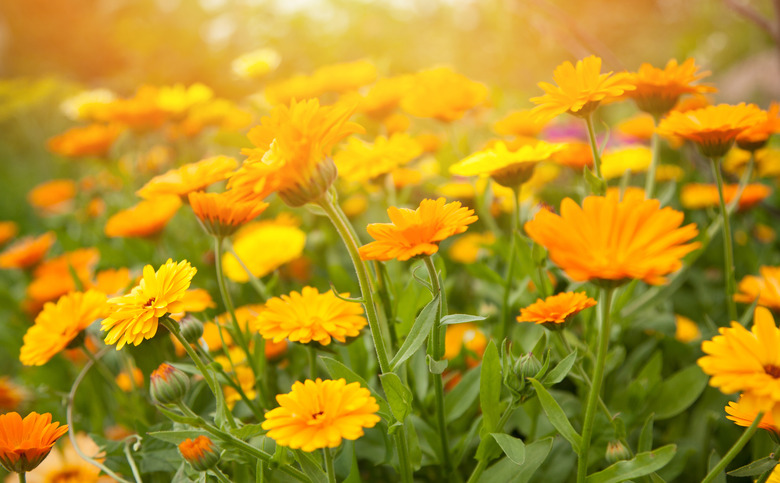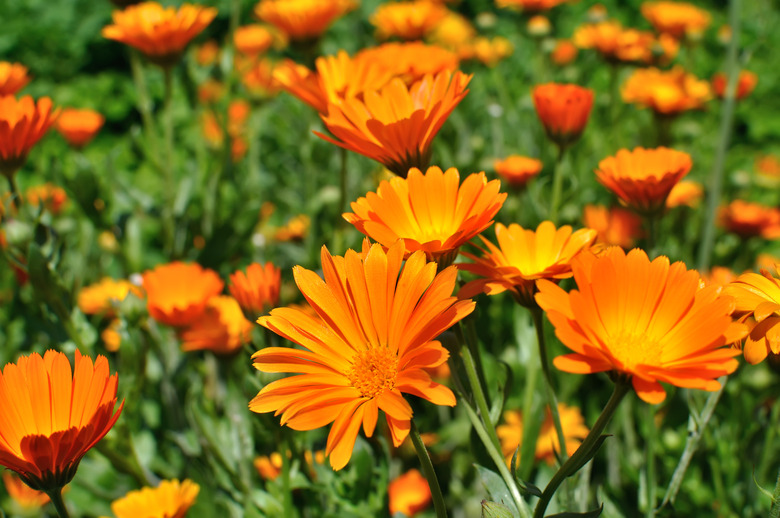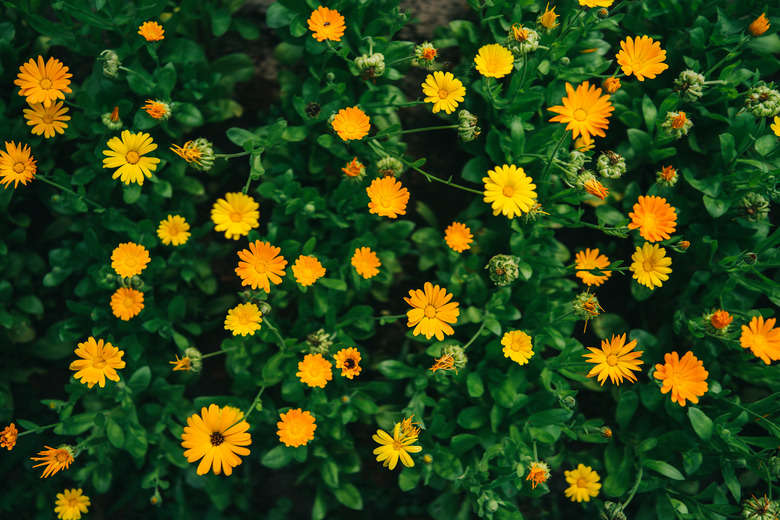How To Grow Calendula
If you are looking to add a bright, cheery vibe to your garden, look no further than the calendula (Calendula officinalis). Often called pot marigolds or English marigolds, don't confuse these plants with the popular orange and yellow flowers of the common marigolds in the Targetes plant genus. Both marigolds and calendulas are part of the daisy family (Asteraceae), but that is where their similarities end.
Calendula produces sweet-smelling flowers in shades of white, yellow and gold. These plants typically spread about 1 to 1 1/2 feet wide and reach heights of about 2 feet. Because it likes cooler weather, calendula is an excellent way to add early spring and late fall color to your garden, providing cheerful blooms before and after many other flowering plants. In addition to adding pops of bright colors, calendula attracts several beneficial insects including some that attack aphids and thrips.
Alas, calendula is an annual plant whose beauty will come to an end when freezing temperatures return to your garden in the winter. Fortunately, calendula is easy to grow from seed, so you can plant it and enjoy it again next year.
Best Uses for Calendula
Best Uses for Calendula
Historically, the ancient Romans used calendula to ease the pain of scorpion stings. In the Middle Ages, the plant served as a bit of a panacea, treating everything from an upset stomach to smallpox. Herbalists today still use calendula to create a salve for treating burns, cuts and scrapes, but most home gardeners grow the plant for its bright and cheery flowers.
You can plant calendula in any sunny spot where you need a little visual interest, but breeders have worked to create hybrids for specific purposes. Some varieties were bred to stay shorter and more compact, making them perfect for borders and edges. Others boast extra-long stems so you can easily enjoy a bouquet of cut calendulas indoors.
If you have an adventurous palate, note that calendula are edible flowers. Some people like to add them to salads and soups. You can also dry calendula and use it as you would saffron in rice and other dishes.
How to Grow Calendula
How to Grow Calendula
- Common Name: Calendula, pot marigold, English marigold
- Botanical Name: Calendula officinalis
- When to Plant: Wait until nighttime soil temperatures are at least 55 degrees Fahrenheit
- USDA Zones: Grow as an annual in zones 3-10
- Sun Exposure: Full sun or part shade
- Soil Type: Moist, well-draining soil
- When it's in Trouble: Drooping flower heads that go to seed quickly
- When it's Thriving: Produces bright, cheery flowers on healthy stems
Starting Calendula From Seed
You can sow calendula seeds directly in the garden after the last frost passes. Don't wait too long, however, as calendulas like cool weather. The earlier you plant them, the longer you will have to enjoy the blooms before the plants possibly go temporarily dormant in the midsummer heat.
To sow your seeds directly, work a few inches of compost into your soil. Drop seeds every 6 inches and cover them with 1/4 to 1/2 inch of soil. Pat the soil over the seeds gently and then water them. Keep the soil slightly moist, and your seeds will germinate and start poking through the ground in seven to 14 days.
If you prefer, you can get a head start on the spring growing season by starting your seeds indoors. Do so about three to four weeks before you expect the last frost in your area.
If you want continuous flowers on your calendulas without any downtime, keep sowing calendula seeds about once a week throughout the spring. Calendulas bloom six to eight weeks after planting. You can plant a second or third batch so that one set of plants can flower while another is recovering and getting ready to flower again.
Starting Calendula From a Seedling
If you started your plants indoors, remember to set them outside for a few hours every day before transplanting them. Gradually keep the plants outdoors for longer periods of time, giving them about a week of this treatment. Doing so will acclimate your plants to outdoor weather so they are not shocked when you transplant them.
Dig planting holes that are large enough to cover the seedling's entire root ball. Plant the seedling to the same depth it enjoyed in its container. Gently water your seedlings immediately after planting.
In What Zone Does Calendula Grow Best?
In What Zone Does Calendula Grow Best?
Because calendula are annual flowers, you can grow them anywhere in USDA plant hardiness zones 3 through 10. Some gardeners can also get away with planting them in zone 2, but the growing season is short there, and you may find your flowers fading more quickly than you can enjoy them.
Calendula can flower and thrive from early spring to late fall in many areas. In cooler climates, calendula will likely bloom until the first killing frost in the fall. In warmer areas, it is likely that calendula will succumb to intense summer heat. If so, the plants may bloom again in the fall season.
When Should You Plant Calendula?
When Should You Plant Calendula?
You should plant calendula after the danger of frost has passed and when the soil temperature is at least 55 degrees Fahrenheit. Calendula likes cool weather, so it is best to plant as early in the spring as you can. In USDA zone 7, for example, this means planting in April or May for flowers all summer.
In areas with summer temperatures above 85 degrees Fahrenheit, the summer heat may kill your calendulas, forcing you to plant in the spring and the fall. In zone 8, you should plant calendula in March or April, and you may have to plant again in September or October. In zone 10, you can plant at any time from February to October.
Soil, Sunlight and Water Recommendations for Calendula
Soil, Sunlight and Water Recommendations for Calendula
Calendula loves direct sunlight, but the afternoon sun may prove to be a bit too much if temperatures climb above 85 degrees. When that extreme summer heat sets in, calendula may need part shade to help keep it cool.
Rich, moist soil makes calendula happy, but add nutrients and fertilizers carefully. Fertilizer that is high in nitrogen will make your plants produce lots of leaves at the expense of flowering. If you want more blooms, give the plant a phosphorous-heavy fertilizer once a month. When the blooms die, cut them off the plant to encourage new flowers.
Water your calendulas frequently until they establish themselves. You can water established plants less often but watch for drooping flower heads that go to seed quickly. This is a sign that your plant is stressed and likely needs more water than you are providing.
Calendulas often re-seed themselves throughout the growing season, and you need not worry about the process. Calendulas may be prolific, but they are not invasive, so there is no need to worry about self-seeding plants taking over your garden. If anything, they will simply add more color.
During periods of hot weather, your calendulas may wilt and look a bit worse for wear. If they do, cut flowers back to a height of 3 inches. They will rejuvenate themselves and do so quite quickly when the temperature drops again.
The first hard frost of the winter season will kill your calendulas, When it has, dig up the dead plants and compost or dispose of them.
How to Harvest Calendula
How to Harvest Calendula
If you want to try eating your calendula or making a salve from it, harvest the plant by snipping off the flowers just after they bloom with sharp pruning shears. You should have plenty of flowers from which to choose, but you can also trim off and eat the leaves of the plant if you don't think you have enough flowers.
You can use your freshly harvested calendula immediately or make oil from it by soaking the blossoms for a few days. Simply combine equal parts of calendula flower petals and oil (sunflower oil and olive oil are good choices) in a jar and leave it to sit for a few days. Strain out the calendula petals and the oil is ready to use. If desired, you can add beeswax to make a salve for cuts and burns.
You can also dry calendula flower petals by spreading them out in a single layer on a plate or towel. Keep them in a shaded, cool area until they are dry enough to crumble. Dried calendula works well in place of more expensive saffron.
Common Pests and Other Problems for Calendula
Common Pests and Other Problems for Calendula
Many gardeners grow calendula flowers with no problems. You could, however, encounter slugs and snails on your plants. Picking them off by hand is usually enough to solve the problem. Aphids may also make an appearance, and a blast of water from your hose will take care of them.
Unfortunately, cabbage loopers, whiteflies and leaf hoppers sometimes visit calendula plants. Fortunately, you can treat these pests simply with an insecticidal soap. Treat them only if you must, however, because calendulas also attract many beneficial insects that could get caught in the crossfire between you and unwanted garden pests.
Common Diseases of Calendula
Common Diseases of Calendula
Calendulas have no special diseases to call their own, but they are susceptible to rots and mildews like other plants. To prevent problems, space your plants appropriately to allow air circulation and stay out of the garden when it is wet. Mulch around your plants to minimize weeds and keep your garden free of debris, like fallen leaves and twigs.
When irrigating calendula, target the plants' roots rather than the leaves. To prevent stem rot specifically, allow the soil around the plant to dry out before watering again.
References
- American Meadows: How to Grow Calendula
- Planet Natural Research Center: Calendula
- The Old Farmer's Almanac: Growing Calendula: How to Grow Pot Marigold
- Gardening With Charlie Nardozzi: How to Grow: Calendula
- Cornell University: Calendula
- Missouri Botancal Garden: Calendula officinalis
- Harvest to Table: How to Grow Calendula


